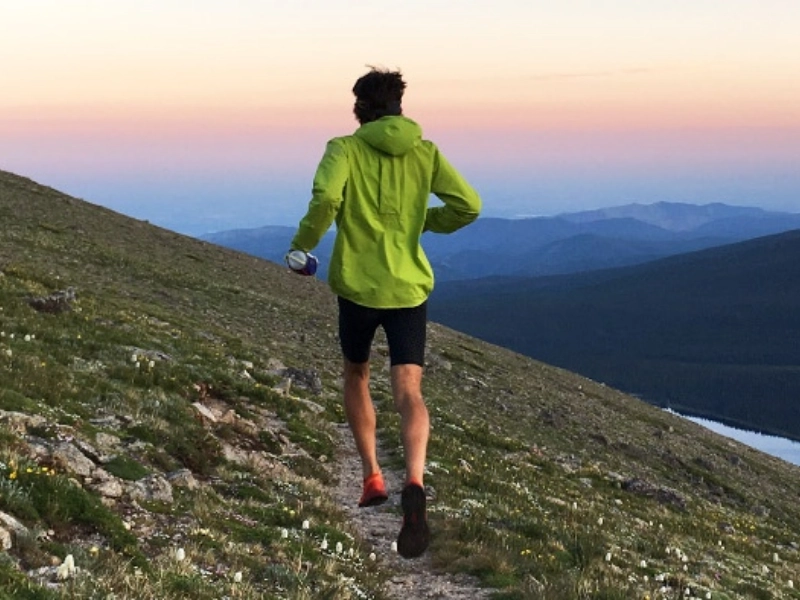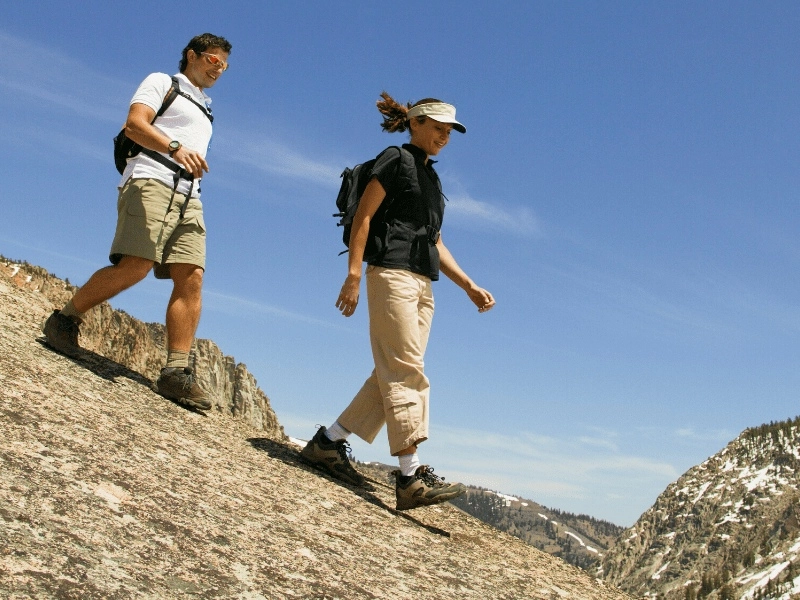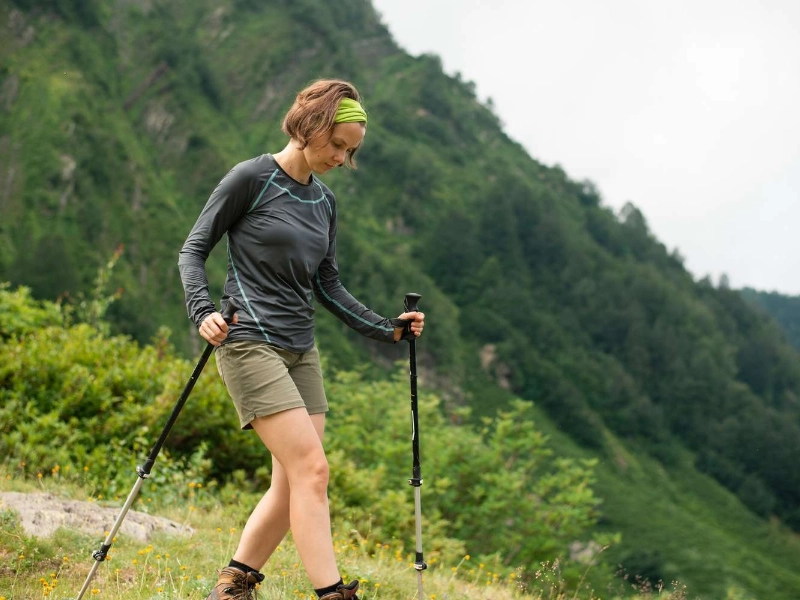There is a lot of impact on your legs, particularly the knees, when walking downhill. This can be quite taxing on your knees because it combines the force of your weight pressing down on the ground with eccentric muscle contractions. Strengthening your muscles and joints will help them better absorb the stress of each step, making walking downhill less painful. These three exercises will assist you in achieving that.

 The hamstring muscles (biceps femoris, semimembranosus, and semitendinosus) near the rear of your upper legs facilitate knee flexion as you walk downhill. They also assist you in regulating your hip flexion during squats and walks. Maintaining the strength of these muscles will help you avoid the type of knee soreness that results from walking too much on a downhill course and not doing enough strength training to balance the loads on your hamstrings and quadriceps.
You can incorporate this intermediate-level exercise into a leg day or core routine to target your hamstrings. While lying on the floor, stretch your legs out in front of you and place a tennis ball or foam roller beneath one knee. Roll the leg carefully up and down, stopping under swollen spots and activating your core during the process.
A fantastic technique to warm up before trekking downhill is to incorporate dynamic hamstring workouts, such as step-downs with a box, bench, or rock (see the videos below). These can also aid in the rehabilitation of hamstring strains caused by running, biking, or climbing.
The hamstring muscles (biceps femoris, semimembranosus, and semitendinosus) near the rear of your upper legs facilitate knee flexion as you walk downhill. They also assist you in regulating your hip flexion during squats and walks. Maintaining the strength of these muscles will help you avoid the type of knee soreness that results from walking too much on a downhill course and not doing enough strength training to balance the loads on your hamstrings and quadriceps.
You can incorporate this intermediate-level exercise into a leg day or core routine to target your hamstrings. While lying on the floor, stretch your legs out in front of you and place a tennis ball or foam roller beneath one knee. Roll the leg carefully up and down, stopping under swollen spots and activating your core during the process.
A fantastic technique to warm up before trekking downhill is to incorporate dynamic hamstring workouts, such as step-downs with a box, bench, or rock (see the videos below). These can also aid in the rehabilitation of hamstring strains caused by running, biking, or climbing.
 Walking downhill necessitates that your calf muscles assist you in pushing off and raising your heel. They also help to keep your knees and ankles stable when you walk. Strengthening your calves will help lessen the strain on your joints and save you from falling, which is one of the main ways that hiking injuries occur.
You may improve your calf muscles for walking downhill by engaging in workouts that emphasise eccentric action, which is the process of strengthening a muscle as it lengthens. Single-leg heel raises are a popular exercise. Place your feet a little distance apart, and raise your heel as high as you can. After a count, release your heel and slowly return it to the floor. Continue with the opposite leg.
Lunges and squats are two of the many #legday exercises that build your calves in addition to your quadriceps and hamstrings. A plie squat, which is a lunge with the front foot lifted, introduces a variant that targets the calf.
Walking downhill necessitates that your calf muscles assist you in pushing off and raising your heel. They also help to keep your knees and ankles stable when you walk. Strengthening your calves will help lessen the strain on your joints and save you from falling, which is one of the main ways that hiking injuries occur.
You may improve your calf muscles for walking downhill by engaging in workouts that emphasise eccentric action, which is the process of strengthening a muscle as it lengthens. Single-leg heel raises are a popular exercise. Place your feet a little distance apart, and raise your heel as high as you can. After a count, release your heel and slowly return it to the floor. Continue with the opposite leg.
Lunges and squats are two of the many #legday exercises that build your calves in addition to your quadriceps and hamstrings. A plie squat, which is a lunge with the front foot lifted, introduces a variant that targets the calf.
 When walking downhill, the hip muscles are quite important. You temporarily transfer all of your body weight to one leg with each downward stride you take. To support this load, your ankle, knee, and hip muscles must be strong enough to support this load in order to do this.
Engaging in activities that require extended periods of tension can also help build the strength required for trekking downhill. Plyometric exercises, such as single-leg 1/4 squats, can help your legs learn how to absorb shock and move properly on uneven surfaces.
A standard step-down variant with an elevated heel is another beneficial workout. As you stand, place your foot on the raised heel of the box, stool, or plyometric platform in front of you. Remaining in a squat stance, gradually lower yourself until your knees are parallel to your feet. Repeat on each side for a count of six to ten repetitions.
When walking downhill, the hip muscles are quite important. You temporarily transfer all of your body weight to one leg with each downward stride you take. To support this load, your ankle, knee, and hip muscles must be strong enough to support this load in order to do this.
Engaging in activities that require extended periods of tension can also help build the strength required for trekking downhill. Plyometric exercises, such as single-leg 1/4 squats, can help your legs learn how to absorb shock and move properly on uneven surfaces.
A standard step-down variant with an elevated heel is another beneficial workout. As you stand, place your foot on the raised heel of the box, stool, or plyometric platform in front of you. Remaining in a squat stance, gradually lower yourself until your knees are parallel to your feet. Repeat on each side for a count of six to ten repetitions.